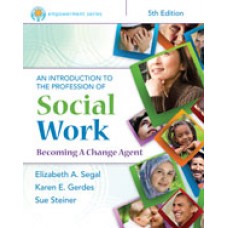This is completed downloadable of Test Bank for Empowerment Series An Introduction to the Profession of Social Work, 5th Edition

Product Details:
- ISBN-10 : 1305258991
- ISBN-13 : 978-1305258990
- Author:
Segal, Gerdes, and Steiner’s AN INTRODUCTION TO THE PROFESSION OF SOCIAL WORK introduces readers to the social work profession and describes the role of social worker in the social welfare system. Through case studies, personal stories, and exercises, this social work text helps readers apply the concepts and truly understand what it means to be a social worker. Part of the Brooks/Cole Empowerment Series, the fourth edition is completely up to date and thoroughly integrates the core competencies and recommended practice behaviors outlined in the most recent Educational Policy and Accreditation Standards (EPAS) set by the Council on Social Work Education (CSWE).
Table of Content:
- Ch 1: What Is Social Work?
- Ch 1: Introduction
- Social Work as a Profession
- Central Concepts and Theories
- The Power of Language
- Social Work Values and Ethics
- Social Work Careers
- Is Social Work for You?
- Choosing Social Work as a Career
- Ch 1: Conclusion
- Ch 1: Key Terms
- Ch 1: Questions for Discussion
- Ch 1: Change Agent Exercise
- Ch 1: Chapter Exercises
- Ch 1: References
- Ch 2: The History of the Social Welfare System and the Social Work Profession
- Ch 2: Introduction
- How the Social Welfare System Helps People
- The History of U.S. Social Welfare
- Major Social Welfare Programs
- Cash Assistance Programs
- The History of the Social Work Profession
- Values, Social Welfare, and Social Work
- Ch 2: Conclusion
- Ch 2: Key Terms
- Ch 2: Questions for Discussion
- Ch 2: Change Agent Exercise
- Ch 2: Exercises
- Ch 2: References
- Ch 3: Poverty and Economic Disparity
- Ch 3: Introduction
- Defining Poverty
- The Causes of Poverty
- The Costs of Poverty
- The Roles of Social Workers
- Ch 3: Conclusion
- Ch 3: Key Terms
- Ch 3: Questions for Discussion
- Ch 3: Change Agent Exercise
- Ch 3: Exercises
- Ch 3: References
- Ch 4: Human Rights and Social and Economic Justice
- Ch 4: Introduction
- What Is Social Justice?
- Explanations of Social Injustice
- Models of Intergroup Relations
- Overcoming Social Injustice
- Social Work Roles in Fighting Social Injustice
- Social Justice and Civil Rights in the Twenty-First Century
- Ch 4: Conclusion
- Ch 4: Key Terms
- Ch 4: Questions for Discussion
- Ch 4: Change Agent Exercise
- Ch 4: Exercises
- Ch 4: References
- Ch 5: Dimensions of Diversity
- Ch 5: Introduction
- Social Construction of Differences
- Diversity in the United States
- Historical Background
- Cultural Competency
- Achieving Cultural Competency
- Emerging Issues
- Ch 5: Conclusion
- Ch 5: Key Terms
- Ch 5: Questions for Discussion
- Ch 5: Change Agent Exercise
- Ch 5: Exercises
- Ch 5: References
- Ch 6: Generalist Social Work Practice
- Ch 6: Introduction
- A Theoretical Framework for Generalist Social Work Practice
- Generalist Social Work Practice with Individuals and Families
- Generalist Social Work Practice with Groups
- Community Practice
- The Role of a Global Perspective in Generalist Practice
- Ch 6: Conclusion
- Ch 6: Key Terms
- Ch 6: Questions for Discussion
- Ch 6: Change Agent Exercise
- Ch 6: Exercises
- Ch 6: References
- Ch 7: Child Welfare: Working with Children and Their Families
- Ch 7: Introduction
- The Importance of Theory
- Theories of Child Development
- The Child Welfare System
- The Roles of Social Workers
- Values and Ethics
- Critical Issues Facing Children and Families
- Working with Children and Families from a Strengths Perspective
- Ch 7: Conclusion
- Ch 7: Key Terms
- Ch 7: Questions for Discussion
- Ch 7: Change Agent Exercise
- Ch 7: Exercises
- Ch 7: References
- Ch 8: Gerontology: Working with People Who Are Older
- Ch 8: Introduction
- Human Development within the Social Context
- Social Work Practice with People Who Are Older
- The Roles of Social Workers
- Values and Ethical Issues
- Critical Issues and Emerging Concerns
- Ch 8: Conclusion
- Ch 8: Key Terms
- Ch 8: Questions for Discussion
- Ch 8: Change Agent Exercise
- Ch 8: Exercises
- Ch 8: References
- Ch 9: Health Care Services
- Ch 9: Introduction
- Health Care in America
- The Roles of Social Workers
- Public Health Policies
- Critical Issues
- HIV/AIDS
- Ch 9: Conclusion
- Ch 9: Key Terms
- Ch 9: Questions for Discussion
- Ch 9: Change Agent Exercise
- Ch 9: Exercises
- Ch 9: References
- Ch 10: Mental Health Services
- Ch 10: Introduction
- Mental Health and Mental Illness
- The Mental Health Care System
- Social Work Practice in Mental Health Settings
- Policy Issues
- Iraq and Afghanistan War Veterans and Mental Health
- Values and Ethics
- Ch 10: Conclusion
- Ch 10: Key Terms
- Ch 10: Questions for Discussion
- Ch 10: Change Agent Exercise
- Ch 10: Exercises
- Ch 10: References
- Ch 11: School Social Work
- Ch 11: Introduction
- The History of School Social Work
- School Social Work Roles and Skills
- Working with Students at Risk
- Critical Public Policies
- Diversity
- Social Work Values and Ethics
- Challenges Facing School Social Workers
- Ch 11: Conclusion
- Ch 11: Key Terms
- Ch 11: Questions for Discussion
- Ch 11: Change Agent Exercise
- Ch 11: Exercises
- Ch 11: References
- Ch 12: Substance Abuse
- Ch 12: Introduction
- Substance Abuse and Human Development
- Substance Abuse Treatment and Prevention
- Diversity Issues and Populations at Risk
- Social Work Values and Ethics
- Emerging Issues and Future Concerns
- Ch 12: Conclusion
- Ch 12: Key Terms
- Ch 12: Questions for Discussion
- How to Become a Change Agent
- Ch 12: Exercises
- Ch 12: References
- Ch 13: Violence, Victims, and Criminal Justice
- Ch 13: Introduction
- Violence, Crime, and Punishment in the United States
- The Criminal Justice System
- Social Work Roles and Skills
- Policy Issues
- Ethics and Values
- Ch 13: Conclusion
- Ch 13: Key Terms
- Ch 13: Questions for Discussion
- Ch 13: Change Agent Exercise
- Ch 13: Exercises
- Ch 13: References
- Ch 14: Crisis, Trauma, and Disasters
- Ch 14: Introduction
- What Do We Mean by Crisis, Trauma, and Disaster?
- Social Work Practice
- Social Work Values and Ethics
- Ch 14: Conclusion
- Ch 14: Key Terms
- Ch 14: Questions for Discussion
- Ch 14: Change Agent Exercise
- Ch 14: Exercises
- Ch 14: References
- Appendix A: NASW Code of Ethics
- Appendix B: Web Resources
- Glossary
- Index
- IBC-1
- IBC-2





